Dwindling Salmon Populations in the Yukon
An examination of hydrologic and climate change factors and its impact on Indigenous communities.
by Carolyn Subramaniam, Annika Krueger, Emma Ware, Dani Zacky, Francine De Castro

The Yukon River means “great river” in Gwich’in while in Yupik it is called Kwig'pak or “large stream.”
“Alaska is the largest state in the nation and home to almost half of the nation’s rivers and lakes. For the most part our water is relatively clean and abundant. Our healthy watersheds support strong populations of fish and wildlife, which provide opportunities that are economically, socially, and culturally vital for many Alaskans. Despite this, people may only be vaguely aware of the essential part Alaska’s water plays in their lives. Everyone has an impact on Alaska’s fish and wildlife resources and the habitats they depend on, but not everyone understands their role in maintaining a sustainable future for these resources.” - Alaska’s Fish and Game Department
Vocabulary:
Anadromous: Fish that are born in freshwater systems, migrate to the ocean to grow into adults, and then return to their natal streams as reproducing adults
Escapement: The number of fish that are allowed to escape fisheries and harvesting and go on to spawn. This number informs the population estimate, fishing quotas, and other management.
Genus: The taxonomic rank above species and below family, used in the biological classification of living and fossil organisms
Keystone Species: A species (in this case, salmon) that drastically has an impact on their environment, such that if they were to be removed a notable effect would be observed on the environment and other species within that environment.
Natal stream: The stream or stretch of river within which a salmon hatched from egg. Salmon remember the “scent” of their natal stream and will use this memory to return to their natal streams to spawn as adults.
Permafrost: A layer of soil beneath the surface that remains frozen year-round
Salmon run: The period of time (usually over a few months) that adult salmon swim upstream to return to their natal streams to spawn
Spawn: Salmon reproduction - where female salmon lay thousands of eggs in a carefully constructed indent in a gravel bed to be fertilized by male salmon
Species: The terminal and most basic unit of taxonomic classification. Individuals of a species can generally only reproduce with other members of the same species.
Watershed: An entire region (or “basin”) which drains waters and allows them to flow into different rivers, basins, or seas a into a river or river system, includes Glaciers, Tributaries, Lakes, Wetlands, and Estuaries
Species Highlight:
Chinook Salmon
Oncorhynchus tshawytscha
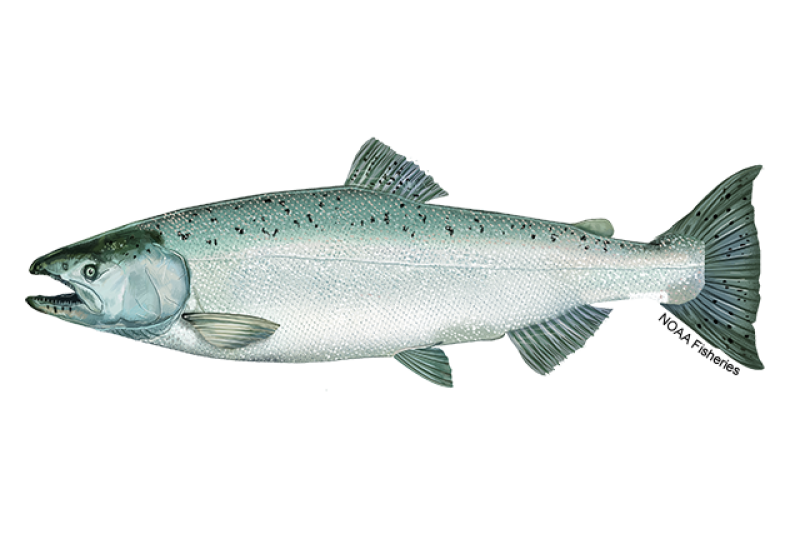
Chum Salmon
Oncorhynchus keta

Oncorhynchus is the genus of salmonids that includes Pacific salmon and trout. Its name is derived from Greek and describes the hooked snout males develop before spawning.
The illustrations above show juvenile/ young adult fish that would be swimming towards the ocean. After their time in the ocean, they will change color when they return to freshwater to spawn (see below!)

A mature male Chinook salmon. Note the hooked snout and red color. Image retrieved from Wild Salmon Center.
Background
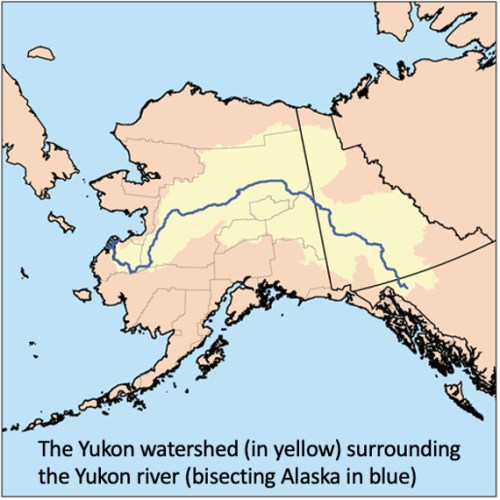
The Yukon River Watershed is one of the largest in the world. The Yukon River itself is the third longest river in North America, and is the longest free-flowing river in the world. It is home to the longest inland Pacific Salmon run in the world. Salmon are vital in the ecology of the Yukon Watershed, they help bring marine nutrients to upstream that benefit inland ecosystems while also supporting other species. In addition to being keystone species, salmon are the cultural backbone to many of the indigenous peoples and communities throughout the Yukon Watershed. The last decade has seen an increasing decline in salmon populations throughout the Yukon River. Between the impacts of climate change and shifts in hydrology, the outlook is not good for salmon or the communities that rely on them.
In 2021 and 2022, Chinook salmon and Chum salmon returns dwindled to nearly nothing, and the Alaska Department of Fish and Game was forced to close the fishery on the Yukon river. Alaska streams normally receive a single run of Chinook salmon in the period from May through July. Chinook salmon often make extensive freshwater spawning migrations to reach their home streams on some of the larger river systems. Chum salmon have two runs a year - one in the summer and one in the fall.
“As Chinook salmon enter the Coastal Area and each district and tributary, subsistence salmon fishing will be closed. This closure may be weeks long until the midpoint of the Chinook salmon run is assessed at Pilot Station sonar (likely around June 23). If inseason assessment indicates a run closer to the lower end of the outlook, subsistence fishing for Chinook salmon will remain closed.”
“If confidence is high that the Chinook salmon run is near the upper end of the outlook, and escapement goals are likely to be met, some subsistence fishing opportunities (on reduced fishing schedules) with gillnets may be allowed. For most districts and areas, gillnets will be restricted to 6-inch or smaller mesh.”

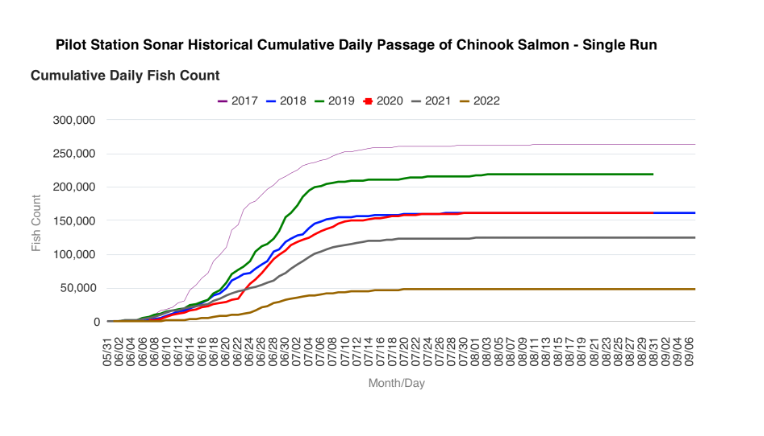


Source: https://www.adfg.alaska.gov/index.cfm?adfg=commercialbyareayukon.main
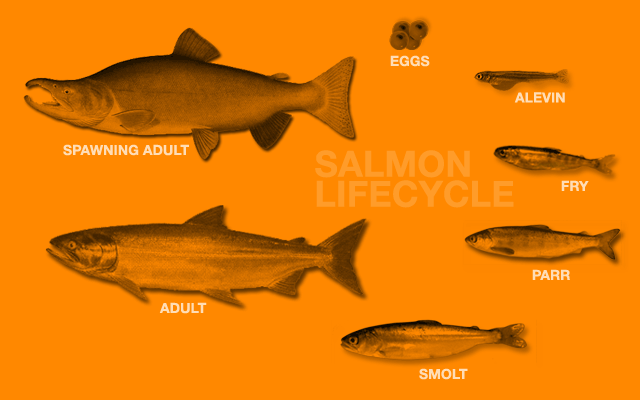
Source: https://www.pbs.org/wnet/nature/salmon-running-the-gauntlet-salmon-lifecycle/6559/
Biology:
The specifics of salmon biology will differ depending on their specific species. There are five types of salmon that run in the Yukon River: Chinook (King) salmon, Coho, Chum, Pink, and Sockeye. These species are all anadromous, meaning they are born in freshwater, migrate to the ocean, and eventually return home to their natal streams to spawn. Salmon use olfactory memory, that is, they use their sense of smell to find the stretch rivers and streams that they were born in.
Life Cycle:
Salmon are born in freshwater streams, some species spend anywhere from a few months to a year in these streams going through the fry and parr stages before becoming smolt and heading to the ocean. In the ocean, salmon will spend years eating krill, smaller fish, and crustaceans growing larger and stronger and into adults. Eventually they will become spawning adults, and the mass they accumulated while at sea will allow them to head back upstream to their home waters to spawn. When migrating from the ocean to their natal stream, a salmon’s digestive system will completely atrophy. Their natural instinct is to devote all of their effort and energy to returning to their natal stream, and will spare little attention to pursuing prey. Whatever nutrients that they have stored in their bodies must be enough to sustain them to get to their spawning grounds. Once salmon spawn, they are classified as Kelt. Because they have expended all of their energy in getting to their natal streams, they grow weak after the spawning process and typically die within a week or two. Their carcasses either wash up on river banks or remain in the river to decay, donating the remaining nutrients they gained in the ocean to the inland riparian environments.
Habitat:
Because salmon are anadromous, they rely on a vast range of ecosystems and habitats. Healthy floodplains are one of the most critical habitats salmon rely on; they provide protection for eggs from flood, shelter from predation, and ample food supplies. River conditions play a role in salmon health in many ways. Other important ecosystem factors include flows, turbidity, temperature, and water chemistry. In the ocean, salmon rely on a healthy and balanced ecosystem that supplies an abundance of food and moderate predation risk. When these habitats are imbalanced or compromised it impacts salmon populations.
Society and People
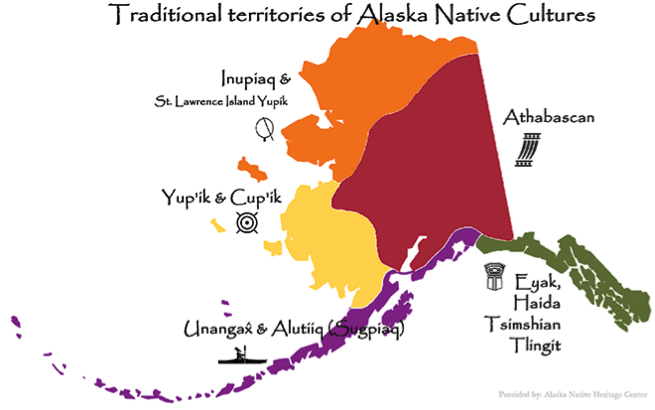
Source: https://www.alaskanative.net/cultural-knowledge/
Tribal Perspectives
The Yukon River Inter-Tribal Watershed Council unites 73 First Nations and Tribes from all along the Yukon River watershed. This Council has a goal that the Yukon water will be clean and drinkable by 2050. Their priorities include solid waste management, water quality testing, and removal of contaminated brownfield sites.
Local tribes have relied on subsistence harvest of King (Chinook) and chum for generations, but their connection transcends food. Salmon are central to cultural traditions that have endured millenia.
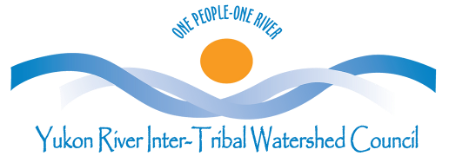
ACTION ITEMS TRIBES ARE ADVOCATING FOR
-
- Genetic testing to ensure wild salmon are not being harvested for commercial fisheries
- Increased sonar capabilities to track fish returns to BC headwaters
- Recognition of their right to fish
Due to extraordinarily low levels of salmon, fishing of these 2 species was banned completely on the Yukon River. Many Tribes are “outraged” that even subsistence fishing was banned, resulting in fewer food stores for winter and a disruption to their millenia-old cultural practices surrounding the salmon harvest. In remote Alaska, grocery stores are not readily available and prices for food staples can be prohibitive. “94% of households in the Yukon Flats depend on traditional hunting and fishing, not only for food security but for their cultural survival”.
MOVING FORWARD
Tribes need a seat at the table in Yukon River fisheries decision making, to pay respect to their extensive knowledge of and cultural connection to the wellbeing of these species.
Climate Change
Climate change consequences are exacerbated in the poles, and the Yukon river basin stretches across the Arctic through western Canada and Alaska so it is incredibly susceptible to climate change. Rising temperatures, melting permafrost and larger ecosystem implications are having large impacts on the salmon population and the local communities.
Melting permafrost

Permafrost is permanently frozen soil in thick layers that covers 50% of Canada’s land surface and 82% of Alaska’s. The earth’s permafrost contains 1500 billion tons of carbon and huge reserves of ancient methane that are starting to be released into the atmosphere. As shown in the figure above, the Yukon river basin stretches across a mix of sporadic, discontinuous and continuous permafrost. As permafrost thaws, it brings a range of issues for the region by releasing carbon, methane, mercury, nitrous oxide and diseases into the atmosphere, as well as impacting the landscape and the flora and fauna depending on it. As temperatures rise at an alarming rate in the Arctic, permafrost will begin to melt, resulting in a positive feedback cycle, with increased thawing every year.
Permafrost underlies much of the Yukon river bed and as the rivers begin to warm, the minerals and nutrients that were stored in the permafrost are being released into the river. When the Yukon spills out into the Arctic Ocean in Alaska, the chemistry of the ocean begins to change, impacting currents and weather patterns in the Arctic. Studies have shown that there have been increased concentrations of calcium, magnesium and sulfate in the last 30 years in the Yukon and the Tanana River, one of its large tributaries.
As the temperature rises, the river is not able to stay frozen as long as it used to, which leads to higher erosion levels from the river bed and banks. The river is flowing for more time over the year which has led to a jump of phosphorus levels by 200%.
When organic matter is frozen into permafrost, the mercury that is associated with it is also frozen into the ground. As the permafrost begins to thaw, organic matter accumulated over large time scales resumes decomposition and subsequently releases mercury . Currently, the Yukon is dumping out 32 times more mercury than river basins of a comparable size in the Arctic Ocean. Fish are going to be heavily impacted by this increase in mercury unfreezing and studies have shown that mercury concentrations are already increasing. If we continue with our emission levels, fish will exceed the safety guidelines for mercury concentrations by 2050. If emissions are curbed to meet the goals of the Paris Agreement, then we will be saved from the consequences of mercury leakage from thawing permafrost.
Further reading on permafrost thaw
- Anthony, L. (2019, April 2). Arctic permafrost is thawing. here's what that means for Canada's north - and the world. Canadian Geographic. Retrieved November 20, 2022, from https://canadiangeographic.ca/articles/arctic-permafrost-is-thawing-heres-what-that-means-for-canadas-north-and-the-world/
- Banks, K. (2018, February 21). The big thaw. Canadian Geographic. Retrieved November 20, 2022, from https://canadiangeographic.ca/articles/the-big-thaw/
- Toohey, R. C., Herman-Mercer, N. M., Schuster, P. F., Mutter, E. A., & Koch, J. C. (2016). Multidecadal increases in the Yukon River basin of chemical fluxes as indicators of changing flowpaths, groundwater, and Permafrost. Geophysical Research Letters, 43(23). https://doi.org/10.1002/2016gl070817
Rising water temperatures
With Salmon spending time in the Bering sea and Yukon river, both ecosystems have an impact on their survival and habitat availability. As the Arctic warms, so does the water which makes it difficult for flora and fauna adapted to the ecosystem to survive. The Yukon empties out into the Bering sea which is already seeing large decreases in sea ice because of rising temperatures. As shown in the Figure, temperatures in Alaska have increased by 3 degrees Fahrenheit since 1925 while the rest of the US has only increased by 1.8 degrees Fahrenheit since 1900. It is evident that Alaska is already experiencing more severe climate change consequences and as the air temperature warms so does the water since they are coupled.
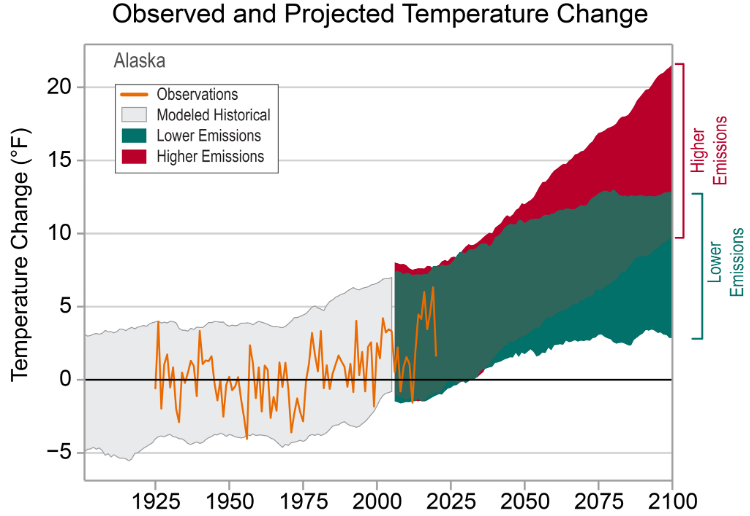
In the next 50 years, warming in the region is expected to rise another 2 degrees. This is double the increase of Southern Canada and the rest of the globe. Precipitation is projected to increase 10-20% in the same period.
As the temperature warms, glaciers along rivers are melting faster and this has coined the term ‘river piracy’. River Piracy is “the diversion of the headwaters of one stream into another one—can dramatically change the routing of water and sediment, with a profound effect on landscape evolution” (Shugar et. al). This phenomenon is taking place at the Kaskawulsh glacier, located on a tributary of the Yukon river, where the glacier melted so rapidly that the river started flowing backwards into the pacific ocean instead of feeding into the Yukon. This can have larger impacts on the ecosystem like changed nutrient fluxes, sediment transport and discharge.
Further reading on rising temperatures
- Stewart, B., & Kunkel, K. (1970, January 1). State climate summaries 2022. Alaska - State Climate Summaries 2022. Retrieved November 22, 2022, from https://statesummaries.ncics.org/chapter/ak/
- Streicker, J., 2016. Yukon Climate Change Indicators and Key Findings 2015. Northern Climate ExChange, Yukon Research Centre, Yukon College, 84 p.https://www.yukonu.ca/sites/default/files/inline-files/Indicator_Report_Final_web.pdf
- Schwartz, J. (2017, April 17). Climate change reroutes a Yukon River in a geological instant. The New York Times. Retrieved November 20, 2022, from https://www.nytimes.com/2017/04/17/science/climate-change-glacier-yukon-river.html
Ecosystem Impacts
The escapement of Yukon River Chinook salmon varied with air and sea temperatures and sea ice cover and factors that influence the water level and freshening of rivers, as well as the strength, duration and directions of prevailing coastal winds, affect survival of salmon during coastal migration and the subsequent run.
Climate change’s impact on the yukon river ecosystem is becoming increasingly apparent especially for indigenous communities that rely on it for sustenance. Warming temperatures are resulting in changes of timing and magnitude of biomass deposition and production on seasonal cycles. This shift can impact the spawning and egg release of salmon that are dependent on seasonal cycles for their life cycle. Not only does this impact salmon but also the wider food web since all species are dependent on one another.
A survey along the northwest coast of the U.S. indicated that there are large areas of water that are depleted of thiamine. This can have a bottom-up influence on the marine food web. Thiamine, vitamin B1, is an essential nutrient that is obtained from prey. Animals such as salmon can become thiamine deficient if they eat prey low in thiamine or high in an enzyme called “thiaminase,” which breaks down thiamine. Plankton blooms and small invertebrates are having a harder time to survive which the fish rely on for food. With collapsing food webs, salmon have been relying heavily on sardines and anchovies, fish in the Clupeid family, which have thiaminase. Salmon that have been primarily eating sardines and anchovies have the thiamine in their bodies metabolized by their prey’s thiaminase, which means that the salmon have less thiamine to give to their eggs. Many juvenile salmon have been dying as a result of thiamine deficiency.
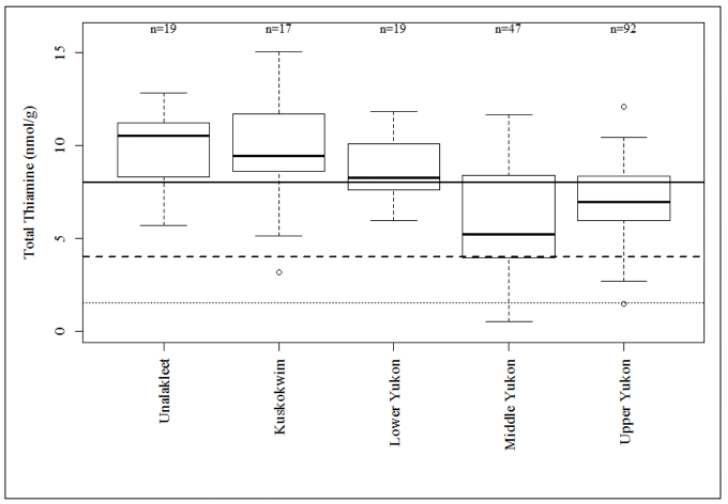
Further reading on ecosystem impacts:
- Tape KD, Gustine DD, Ruess RW, Adams LG, Clark JA. Range Expansion of Moose in Arctic Alaska Linked to Warming and Increased Shrub Habitat. PLoS One. 2016 Apr 13;11(4):e0152636. doi: 10.1371/journal.pone.0152636. Erratum in: PLoS One. 2016;11(7):e0160049. PMID: 27074023; PMCID: PMC4830447.
- Larson, S, & Howard, K. (1970, January 1). Exploration of AYK Chinook Salmon Egg Thiamine Levels as a Potential Mechanism Contributing to Recent Low Productivity Patterns. Alaska Department of Fish and Game 2019. Retrieved November 22, 2022, from https://www.adfg.alaska.gov/FedAidPDFs/FDS19-22.pdf
- Ullah H, Nagelkerken I, Goldenberg SU, Fordham DA (2018) Climate change could drive marine food web collapse through altered trophic flows and cyanobacterial proliferation. PLoS Biol 16(1): e2003446. https://doi.org/10.1371/journal.pbio.2003446
Water

On top of being the third largest river in North America, the Yukon River is the fourth largest drainage basin in North America, stretching nearly 2,000 miles from the Yukon in Canada to Alaska. Approximately 126,000 people live within the basin.
Negative hydrologic factors on the Yukon that are impacting salmon include:
Melting permafrost, which is the frozen layer under the active layer of soil, releasing previously frozen minerals, nutrients, and contaminants. This is changing the chemical composition of the river - increasing the amount of calcium, magnesium, and sulfate.
Increasing river temperatures - salmon rely on cold waters, warming temperatures can impact spawning, and increased risk of disease like ich (a parasitic disease) and gill rot (a fungal disease).
Flooding events - Because of climate change, the river is freezing later than usual and staying frozen for a shorter period of time. This is increasing the amount of water in the river and making flooding events more common along the banks. Typically, salmon are more tolerant of “crowding” over the winter, and will try to find shelter in deep pools, under woody debris, and in underwater structures (like rocks and small caves). For salmon that overwinter in these rivers, flood events mean that they have to risk surviving in the flood’s higher flows.
There are 167 dams restricting the passage of water in Alaska, and the The Yukon River watershed alone is about 300,000 sq. miles. These dams not only restrict water flow, which slows water passage through the rivers, they also restrict fish passage past the dam.
Source: https://yukonwater.ca/understanding-yukon-water/climate-change-and-water/changes-to-water-resources/
FAQ
- How do salmon find their way back to their “home waters”?
- Salmon use their olfactory senses in the imprinting process so that they can find their natal waters to spawn in during adulthood.
- How far do salmon travel?
- Salmon travel the distance from their home stream to the ocean which can be hundreds of miles and they may travel in the ocean up to Alaska and far out to sea, some up to 1,000 miles.
- Why do salmon die after they spawn?
- Salmon use all their energy for returning to their home stream, for making eggs and digging the nest. Most salmon stop eating when they return to freshwater and have no energy left for a return trip to the ocean after spawning. After they die, other animals eat them (but people don't) or they decompose, adding nutrients to the stream.
- How do Tribes store salmon after it is harvested?
- Salmon can be stored in a variety of ways including being dried into jerky, canned, frozen, or kept in barrels. Learn more and see pictures of traditional drying processes here.
- What is the difference between subsistence hunting and commercial fishing?
- While both commercial and subsistence hunters harvest salmon, the quantity of fish harvested is different. Subsistence hunting, also referred to by Tribes as “Our Way of Life” involves harvesting enough to sustain individuals, communities, and families. Commercial fishing describes a business model dependent on fishery harvests. Read more from the Bureau of Indian Affairs website.
- What percentage of Alaska’s annual fishing harvest is from subsistence hunting?
- 0.9%, or 33.6 million pounds. Recreational fishing makes up 0.5% and the remaining 98.6% are from commercial fishing.
- What is the largest type of salmon?
- Chinook/King Salmon are the largest and get up to 58" long and 126 pounds. While the chinook may be the largest in North America, there are larger species in Asia.
- Further FAQ information can be found here
References and Further Reading
- https://www.yritwc.org/yukon-river-watershed
- https://www.usgs.gov/faqs/how-do-salmon-know-where-their-home-when-they-return-ocean#:~:text=Scientists%20believe%20that%20salmon%20navigate,the%20ocean%20as%20young%20fish.
- https://www.fisheries.noaa.gov/feature-story/whats-behind-chinook-and-chum-salmon-declines-alaska
- https://www.adfg.alaska.gov/FedAidPDFs/FDS19-22.pdf
- https://apnews.com/article/climate-change-science-lifestyle-business-environment-and-nature-cb0c966f43e52fd9559857969f1203a0
- https://www.bia.gov/regional-offices/alaska/subsistence-branch
- https://yukon.ca/sites/yukon.ca/files/env/env-traditional-territories-map-insert.pdf
Anthony, L. (2019, April 2). Arctic permafrost is thawing. here's what that means for Canada's north - and the world. Canadian Geographic. Retrieved November 20, 2022, from https://canadiangeographic.ca/articles/arctic-permafrost-is-thawing-heres-what-that-means-for-canadas-north-and-the-world/
Larsen, C., E. Burgess, A. Arendt, S. O’Neel, A. Johnson, and C. Kienholz, 2015. Surface melt dominates Alaska glacier mass balance. Geophysical Research Letters, vol. 42, p. 5902– 5908, doi:10.1002/2015GL064349.
Larsen, J.N., O.A. Anisimov, A. Constable, A.B. Hollowed, N. Maynard, P. Prestrud, T.D. Prowse, and J.M.R. Stone, 2014. Polar regions. In: Climate Change 2014: Impacts, Adaptation, and Vulnerability, Part B: Regional Aspects. Contribution of Working Group II to the Fifth Assessment Report of the Intergovernmental Panel on Climate Change [Barros, V.R., C.B. Field, D.J. Dokken, M.D. Mastrandrea, K.J. Mach, T.E. Bilir, M. Chatterjee, K.L. Ebi, Y.O. Estrada, R.C. Genova, B. Girma, E.S. Kissel, A.N. Levy, S. MacCracken, P.R. Mastrandrea, and L.L. White (eds.)]. Cambridge University Press, Cambridge, United Kingdom and New York, NY, USA, p. 1567-1612.
Banks, K. (2018, February 21). The big thaw. Canadian Geographic. Retrieved November 20, 2022, from https://canadiangeographic.ca/articles/the-big-thaw/
Permafrost loss dramatically changes Yukon River Chemistry and hydrology with potential global implications: U.S. geological survey. Permafrost Loss Dramatically Changes Yukon River Chemistry and Hydrology with Potential Global Implications | U.S. Geological Survey. (2016, November 30). Retrieved November 22, 2022, from https://www.usgs.gov/news/featured-story/permafrost-loss-dramatically-changes-yukon-river-chemistry-and-hydrology
Toohey, R. C., Herman-Mercer, N. M., Schuster, P. F., Mutter, E. A., & Koch, J. C. (2016). Multidecadal increases in the Yukon River basin of chemical fluxes as indicators of changing flowpaths, groundwater, and Permafrost. Geophysical Research Letters, 43(23). https://doi.org/10.1002/2016gl070817
Vonk, J. E., Tank, S. E., Bowden, W. B., Laurion, I., Vincent, W. F., Alekseychik, P., Amyot, M., Billet, M. F., Canário, J., Cory, R. M., Deshpande, B. N., Helbig, M., Jammet, M., Karlsson, J., Larouche, J., MacMillan, G., Rautio, M., Walter Anthony, K. M., & Wickland, K. P. (2015). Reviews and syntheses: Effects of permafrost thaw on Arctic Aquatic Ecosystems. Biogeosciences, 12(23), 7129–7167. https://doi.org/10.5194/bg-12-7129-2015
Rosen, Y. (2020, September 29). Yukon River, beset by salmon woes and Mercury threats, signals broader arctic climate change. ArcticToday. Retrieved November 20, 2022, from https://www.arctictoday.com/yukon-river-beset-by-salmon-woes-and-mercury-threats-signals-broader-arctic-climate-change/
Fischer, D. (2011, October 25). Yukon River dumping more mercury thanks to climate change. Scientific American. Retrieved November 22, 2022, from https://www.scientificamerican.com/article/yukon-river-dumping-more-mercury-climate-change/
Stewart, B., & Kunkel, K. (1970, January 1). State climate summaries 2022. Alaska - State Climate Summaries 2022. Retrieved November 22, 2022, from https://statesummaries.ncics.org/chapter/ak/
Shugar, D. H., Clague, J. J., Best, J. L., Schoof, C., Willis, M. J., Copland, L., & Roe, G. H. (2017). River piracy and drainage basin reorganization led by climate-driven glacier retreat. Nature Geoscience, 10(5), 370–375. https://doi.org/10.1038/ngeo2932
Streicker, J., 2016. Yukon Climate Change Indicators and Key Findings 2015. Northern Climate ExChange, Yukon Research Centre, Yukon College, 84 p.https://www.yukonu.ca/sites/default/files/inline-files/Indicator_Report_Final_web.pdf
Schwartz, J. (2017, April 17). Climate change reroutes a Yukon River in a geological instant. The New York Times. Retrieved November 20, 2022, from https://www.nytimes.com/2017/04/17/science/climate-change-glacier-yukon-river.html